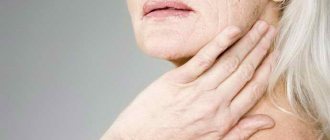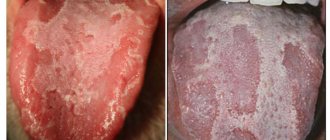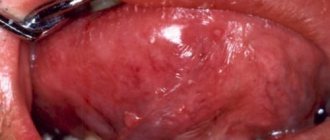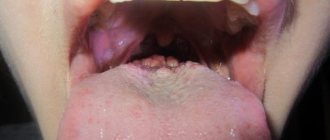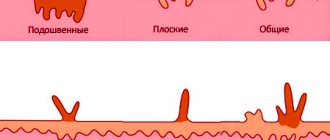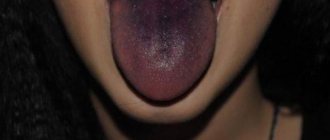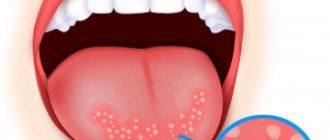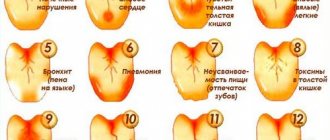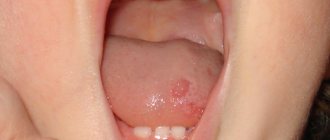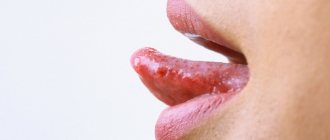Symptoms of a yellow tongue
Yellow coating on the tongue
Some symptoms may appear especially pronounced in the morning after waking up and in the first half of the day. Other signs may be identified during examination for changes that occur simultaneously with the yellow coloration of the tongue.
Researching the symptoms that accompany yellow tongue coating is crucial when it comes to identifying the causes of the condition and prescribing appropriate treatment.
The most common:
- bad breath or (bad breath);
- bad taste in the mouth;
- dry mouth;
- sore throat accompanied by fever;
- the presence of red pimples or spots on the tongue. They may also be found on the throat and tonsils;
- burning sensation in the mouth.
Yellowing of the tongue may indicate a vitamin deficiency
. Other parts of the mouth may also be affected by these changes: gums, palate, inner surface of the cheeks and lips.
It is also possible that symptoms may develop (or subside) in other parts of the body. Analyzing all of these changes at the same time provides important information to your doctor about your health.
Signs of fungal infection and sore throat
Most of these manifestations are also observed in newborns and infants during breastfeeding. One of the main symptoms of a fungal infection is a white coating in the mouth (on the soft and hard palate, tongue, gums, inner surface of the cheeks, etc.)
As we will see below, a sore throat is symptomatic, for example, with a streptococcal throat infection, but at the same time it can occur under other conditions.
Hives on the tongue what to do
Rashes on the tongue are a consequence of inflammation or enlargement of the papillae localized on this organ.
In itself, this is a harmless symptom, but may indicate the progression of a serious illness. In addition to pathological predisposing factors, there is a category of physiological sources, i.e., not associated with a particular pathological process. Among them, it is worth highlighting poor nutrition and addiction to bad habits.
Most often, additional symptoms include a change in the color of the tongue, which occurs against the background of the formation of plaque on it, as well as the appearance of burning and pain.
It is impossible to make a correct diagnosis based only on the clinical picture, which is why diagnosis must necessarily take an integrated approach. A thorough examination of the oral cavity also plays a last role.
The treatment regimen directly depends on the etiological factor, but often conservative methods of therapy are sufficient.
Etiology
A wide range of predisposing factors can cause the appearance of a pathological rash on the tongue, and the causes may differ depending on the age category the person belongs to.
Rashes on the tongue in adults often form against the background of the following pathological conditions:
- any allergic reaction;
- herpes;
- inflammation of the oral mucosa or stomatitis;
- granulosa pharyngitis;
- hypovitaminosis, in which there is a lack of vitamins in the human body;
- a wide range of pathologies leading to a decrease in the resistance of the immune system;
- the occurrence of an inflammatory process directly on the tongue, which is also called glossitis;
- hepatitis or cirrhosis;
- blood diseases;
- oral candidiasis;
- impetigo - in this case, the formation of bubbles filled with clear liquid will be noted;
- pyogenic granuloma;
- liver failure;
- erythema of an exudative nature;
- a chemical burn that can occur due to toxic acidic compounds or highly concentrated alkalis entering the oral cavity.
The causes of a rash on a child’s tongue, in addition to the above sources, can be represented by:
- herpes;
- thrush;
- scarlet fever;
- a side effect from uncontrolled use of medications in the form of tablets, which is equivalent to a chemical burn in adults;
- chicken pox;
- congenital syphilis or other immunodeficiency conditions;
- disturbance of intestinal microflora or dysbacteriosis.
Non-dangerous causes of a rash on the tongue in an adult, less often in a child, are:
- eating excessively hot foods or drinks;
- bone cut;
- reaction to dentures;
- addiction to bad habits, namely smoking cigarettes;
- habit of eating very spicy or salty foods;
- change in bite that occurs after dental procedures;
- the development of an allergic reaction to a particular product, toothpaste or other product intended for oral care.
Classification
A rash on the tongue may not in all cases be small pimples. Neoplasms can also be expressed as:
- bubbles;
- small swellings;
- sores;
- warts;
- inflamed papillae covering the surface of the tongue.
Pathological formations may also differ in their color range, which is why there are:
- white – often occur with candidiasis and stomatitis;
- yellow;
- red – found in the vast majority of cases;
- pink.
However, the main classification of a rash on the tongue of a child or adult is represented by the location of the acne:
- on the tip of the tongue - based on clinical observations, it is generally accepted that damage to this segment indicates the development of problems with the cardiovascular or digestive system;
- under the tongue - is considered a clinical manifestation of quite rare pathologies, in particular Kawasaki syndrome, Kaposi's sarcoma, pernicious anemia or malignant neoplasms;
- at the root of the tongue - this localization of neoplasms is most typical for stomatitis;
- on the sides of the tongue - makes it possible to suspect herpetic sore throat.
Symptoms
A rash on the tongue of a child or an adult will never act as the only clinical sign. In the vast majority of cases, such a symptom will be the first, and against its background other manifestations will begin to develop.
The symptomatic picture will be individual in nature, since it completely depends on the pathological condition that provoked the appearance of rashes on this organ.
Local additional symptoms include:
- redness and swelling;
- pain syndrome, which often has a minor degree of severity;
- itching and burning;
- increase in the volume of regional lymph nodes;
- discomfort when talking or eating;
- a rapid increase in the number of pimples, blisters or sores;
- the formation of abscesses and phlegmons - often observed with complicated stomatitis;
- discharge of clear liquid or blood from the blisters;
- formation of crusts in places where pathological fluid is secreted;
- coating of the tongue with a coating, the shade of which will depend on the etiology. The most commonly observed plaque is white and yellow, but it also comes in green, blue, brown, orange and black.
If one or more symptoms occur against the background of the main symptom, immediate seeking qualified help from a dentist is required.
Diagnostics
Given the fact that a large number of different diseases contribute to the appearance of neoplasms on the tongue in the form of pimples, blisters, swellings or ulcers, it is not possible to make a correct diagnosis based on clinical signs alone.
At the initial diagnosis stage, the clinician should:
- get acquainted with the clinical picture and life history of the patient - often when the occurrence of such a sign does not have a pathological basis, this makes it possible to establish the most characteristic predisposing factor;
- Conduct a thorough dental examination of the oral cavity;
- interview the patient in detail regarding the first time of appearance and severity of both the main symptom and additional symptoms.
The basis of laboratory research is:
- general clinical analysis and blood biochemistry - will indicate the course of the pathological process;
- PCR tests;
- microscopic examination of a scraping taken from the tongue;
- bacterial culture of the contents of the vesicles.
Source: https://geraklionmed.ru/krapivnitsa-na-yazyke-chto-delat/
Causes
“An overgrowth of bacteria or fungi in the digestive tract will often appear as a thick coating on the tongue” [bodyecology.com], which can be white, yellow, green, or brown. Let's explore more possible reasons why your tongue looks yellow.
Regular use or abuse of certain oral medications
If you have recently discovered a yellow coating on your tongue that looks like a film or thin pale yellow stripes, it is time to take a closer look at the medications you have been taking previously. Most cases involving oral medications indicate that a major part of the problem is a group of drugs known as antibiotics.
The chemical composition of medications determines the way in which medications affect tongue discoloration. An example is a class of drugs called antidiarrheals, such as Pepto-Visnol, which contain bismuth subsalicylate as the active chemical ingredient. When such a medicine is mixed with saliva, bismuth sulfide is formed. This chemical component is responsible for changing the color of the tongue. Most often, doctors explain this by saying that some patients freely purchase medications from pharmacies and start using them without thinking about the dosage and timing of taking the drugs.
Black hairy tongue
Early signs of a hairy tongue
There is no hair on the tongue. Doctors call a hairy tongue an increase in the size of the lingual papillae (most often filiform), as well as their compaction and thickening. Outwardly, it looks like thick hair, and causes a person to feel discomfort and a foreign body.
Early signs of this condition are most often recognized as areas on the surface of the tongue (especially at the back of the tongue) that are brown, green, orange, green-yellow, or yellowish in color. The reasons for these changes are poor oral hygiene, tobacco smoking, improper use of certain medications and a number of other reasons. People who do not maintain oral hygiene have abundant bacterial growth. It is important to note that some bacteria have the ability to produce colored pigments that accumulate between and within the papillae of the tongue.
Additionally, people with congenital elongated lingual papillae are more likely to develop symptoms of a black hairy tongue, including a metallic taste in the mouth, foul breath, and a burning sensation.
Postnasal drainage
Normally, there is a constant production of mucus in the “glands of the mucous membrane of the nose, throat, respiratory tract, stomach and intestinal tract,” [webmd.com], which helps prevent the development of infectious inflammation. When mucus is produced in excess, it flows down the back of the nose into the throat (postnasal drainage) and accumulates there. Sometimes this mucus is released through the nostrils.
The function of the mucosa is mainly to trap microorganisms such as bacteria, fungi, and viruses. However, when the flora multiplies vigorously, its increased microbial activity can sometimes lead to the formation of a thick white or yellow coating on the tongue, especially on the back of it.
Sinusitis (inflammatory diseases of the paranasal sinuses), colds, allergies and rhinitis are some of the most common causes of postnasal drip.
The problem can also occur when the mucous membrane does not clear effectively, causing mucus to accumulate in the back of the throat. In this case, the yellowish or white appearance of the tongue is thought to be caused by gastroesophageal reflux disease or old age.
Effects of dehydration
Continuing with the conditions that lead to tongue discoloration, dehydration is also a possible cause. Clinical trials and their results have shown that if your tongue turns yellow, you may be mildly dehydrated. There are many common signs and symptoms of dehydration: decreased frequency of urination, dark urine, feeling thirsty, dry mouth, sudden weight loss.
Irritation and inflammation of the tongue
There are several medical procedures and other reasons that will cause your tongue to become irritated. These include eating too spicy food, tongue piercing, tooth extraction and tonsillectomy (surgical removal of infected or damaged tonsils).
If irritation becomes severe, it will require the use of mouthwash. This helps fight bacteria while promoting healing. For example, "a yellow film on the surface of the tongue 2-3 days after your tongue is pierced" [skin-artists.com] is quite common.
Jaundice
Another possible cause is jaundice, although this is rarely the cause of a yellow tongue. People with liver and gallbladder problems have signs such as yellow skin and yellowish spots on the whites of the eyes, as well as yellowing of the palate and oral mucosa.
Other causes of yellow coating on the tongue
These include:
- Poor bowel function;
- Smoking tobacco;
- Gastroesophageal reflux disease;
- Infections such as streptococcal or mononucleosis;
- Jaundice - although a rare cause of yellow plaque;
- Lack of vitamins.
Causes of red pimples and pimples on the tongue
A thorough visual examination of the inflamed organ is necessary in order to make an accurate diagnosis and conclude that the redness was caused by a pimple. It should be clarified that the occurrence of painful sensations is not associated with mechanical damage received during food intake. You should also make sure that there is no stomatitis, fungal or other infectious diseases of the oral cavity that affect the tongue.
When the papillae on the tongue become inflamed, they increase in size and become red, and they become painful, especially when touched or exposed to food. Popularly, such pimples are called “pipun”. Causes of inflammation:
- Chemical burn due to exposure of aggressive acids or concentrated alkalis to the oral cavity.
- Chemical trauma that a person receives when dissolving certain tablets. The risk of chemical injury due to the tablet form of medications increases if the dose exceeds the recommended limit.
- Thermal burns caused by hot drinks or hot dishes.
- Puncture or cut by bone
- Injury to tongue tissue by dentures.
It is important to reduce the inflammatory process as quickly as possible and stimulate regenerative mechanisms in the tissues of the affected organ. To exclude the presence of an infectious agent as the culprit in the appearance of a red pimple, scraping is required . With its help, a medical professional identifies a pathogenic microorganism, which subsequently makes it possible to prescribe adequate treatment.
There are many reasons for the appearance of red rashes on the tongue:
- Allergic reaction. The allergic nature of the pathology gives a signal about the presence of allergens in oral hygiene products: toothpaste, brush, mouthwash. Allergies can get worse when you eat certain foods.
- Red or white pimples are one of the obvious symptoms of stomatitis. The mucous membrane of the mouth becomes inflamed under the influence of viruses and bacteria. The classification of stomatitis is based on the causative agent of the disease. If stomatitis appears due to non-compliance with hygiene rules, then it will not be difficult to cure it. For this purpose, antibacterial drugs are actively used to sanitize the oral cavity. The help of a dentist is required when the number of inflamed acne increases rapidly.
- Vitamin deficiency. Vitamin deficiencies are a common cause of tongue problems. Lack of B vitamins and folic acid in the body has a detrimental effect. The taste buds turn bright red.
- Granular pharyngitis. Pimples are found on the tongue closer to the throat. The disease is characterized by chronic inflammation of the mucous membranes of the larynx. The back of the throat becomes covered with red blisters, sometimes moving to the tongue. Pharyngitis often occurs after a cold or sore throat.
- Immunosuppressive conditions.
- Digestive problems and dysbiosis, marked by disruption of intestinal microflora and poor absorption of nutrients. For this reason, pimples may appear on the base of the tongue.
- Glossitis. The disease does not affect the mucous membrane of the mouth, only the tongue becomes inflamed. Often occurs due to trauma to the tongue by a tooth or denture. A deviation can develop in the absence of proper oral care due to bad habits. Glossitis can appear against the background of problems with the gastrointestinal tract, anemia and a number of infectious diseases. A mild form of the pathology is characterized by symptoms of stomatitis, that is, red blisters are noticeable on the tongue. The deep form is complicated by ulcers and phlegmon.
- Thrush. Infection of the oral cavity by fungi is called candidiasis. The disease makes itself felt when a person’s immune functions are weakened or a disruption occurs in the functioning of organ systems. Along with increased dryness of the mouth and throat, pimples may appear on the tongue.
- Impetigo. The streptococcal infection penetrates the root of the tongue and causes the formation of superficial blisters containing clear fluid.
- Pyogenic granuloma. In rare episodes, it manifests itself on the tongue in the form of red nodules consisting of blood vessels in the area where there used to be a wound.
- Exudative erythema. The patient complains of red spots and blisters over the entire surface of the tongue. Once ruptured, the blisters leave long-healing ulcers. The reason lies in pathogenic microbes.
- Scarlet fever. It is characterized by inflammation of the entire oral cavity, red pimples affect the tonsils and appear on the tongue.
Yellow sore tongue and oral cancer
Ulcerative defects can be a source of discomfort. They are, for the most part, not a cause for concern as they are usually non-cancerous. According to medical reports, tongue ulcers are usually white or yellow in color, although they may turn gray as they heal.
One of the causes of tongue ulcerations is malignant (cancerous) diseases. There is no information that it is possible to cure them on their own, without treatment. People who have chronic mouth ulcers should definitely see a dentist to determine the cause.
What about oral cancer?
Unlike typical tongue or mouth ulcers, oral cancer is characterized by ulcers that do not go away on their own, meaning they are permanent. These wounds may also become hard and quickly increase in size. This is a sign that there is a possibility of developing oral cancer. Other symptoms of this disease include severe sore throat, hoarseness, difficulty swallowing, and mild fever.
Patients with such symptoms are advised to consult a doctor and undergo a series of medical tests, including to diagnose oral cancer.
How to carry out treatment?
How to treat inflammation on the tongue? What will help remove painful acne that causes a lot of inconvenience? If the red pimples are caused by an illness and home conditions do not allow it to be diagnosed, then it is best to see a dentist or otolaryngologist .
The specialist will conduct the necessary laboratory tests and identify the cause of the disease.
For treatment, the patient may be prescribed medications such as pyridoxine, fungizone, monistat, nystatin. You should be careful and not forget that self-medication usually does not give the desired result, and sometimes aggravates the process.
Recommendations that will help alleviate the patient’s condition until medical help:
- Try not to injure the irritated oral cavity.
- Do not overuse coffee or hot tea.
- Quit smoking and do not drink alcoholic beverages
- Avoid too hot foods, eat spicy and salty foods as little as possible, limit the amount of sugar and seasonings.
- Rinse the mouth with antiseptic solutions, potassium permanganate, chlorhexidine. You can use traditional medicine recipes and rinse your mouth with infusions of medicinal plants: chamomile, calendula, sage. Carry out the procedure before going to bed and after waking up, as well as after eating.
- A fungal infection, as the cause of the appearance of red pimples on the tongue, can be eliminated by rinsing with a soda solution or some antifungal drug, for example, nystatin.
- If the cause of the formation of blisters lies in a viral or bacterial infection, then self-treatment can harm the patient, so you can only relieve unpleasant symptoms by rinsing and drinking plenty of fluids.
Situations that should force a patient to seek medical help:
- If, in parallel with the appearance of pimples on the tongue, red spots and pimples appear on the body
- Body temperature rises.
- The pimples itch and begin to hurt, causing discomfort.
- There is swelling of the gums, lips or palate.
After examining the patient, the doctor may prescribe:
- For allergic genesis of pimples on the tongue, it is recommended to take antihistamines
- Antiseptics are prescribed to speed up wound healing
- Probiotics are prescribed to eliminate dysbiosis
- Antibiotics and anti-inflammatory drugs to destroy bacteriological pathogens.
Yellow tongue is a sign of an STD
Could a yellow tongue be a sign or symptom of sexually transmitted diseases (STDs)? There are a number of sexually transmitted infections (STIs), and one of them is HIV. There may be a relationship between HIV symptoms and the development of a yellow coating or yellowing of the tongue. Although research shows that such a connection is rare in people living with HIV and AIDS.
The truth about STIs such as HIV is that these infections usually reduce the body's ability to fight other infections that affect a person that are quite contagious and common. Especially if you have a compromised immune system, part of your digestive tract—the mouth—can be easily vulnerable to infections. For example, for oral herpes, thrush, etc.
Causes of tongue allergies in adults and children
› Allergy on body
Allergic reactions affect many people on the planet, and their manifestations can be very different. This common disease affects both adult patients and children.
The onset of the disease is associated with individual hypersensitivity to a particular substance and intolerance by the body, which begins to produce a large amount of histamine in order to suppress the action of the allergen. This leads to a number of unpleasant and sometimes dangerous consequences.
Particular discomfort is caused by rashes on the tongue and in the oral cavity of an allergic nature.
Is it possible to have allergies in the tongue area?
As a result of contact with an allergen, a reaction occurs in the body, which can affect different human organs and systems. Therefore, it is not surprising that the language is often subject to such influence.
However, many patients ignore the symptoms - changes in the color of the tongue, the appearance of rashes. Although, even having discovered them, people cannot always associate them with the root cause (the effect of the allergen), so they begin to treat themselves.
This behavior is dangerous and can cause a number of complications.
Glossitis and its varieties
Inflammatory processes that occur in the tongue area and are the result of injuries, microorganisms and other factors are described by the concept of glossitis. This condition is associated both with systematic changes in the tongue, for example, vitamin deficiency, acute infections, dermatoses, and with disturbances in the nature of the structure.
With high frequency, glossitis is provoked by microorganisms - bacteria, viruses, fungi. Sometimes caused by a complex infectious effect of pathogens, for example, simultaneously viruses and fungi. If a person does not have problems with immune defense, then the likelihood of glossitis occurring is minimal.
Inflammatory processes in the tongue (glossitis) are the result of the interaction of various factors that lead to damage to the mucous membrane and suppress the immune system.
Along with allergic glossitis, caused by the action of an allergen and manifested by redness and swelling of the tongue, other types are also distinguished:
- desquamative (exfoliative) – manifests itself due to vitamin deficiency, gastrointestinal disorders, and the presence of parasites in the body;
- Gunterovsky (Hunterovsky) - caused by anemia, which occurs as a result of a deficiency in folic acid;
- candidiasis – associated with changes in microflora in the oral cavity;
- atrophic, resulting from the action of various infections;
- herpetic, caused by the action of the herpes virus, etc.
Causes of manifestation
Factors that play an important role in the occurrence of allergic manifestations in the oral cavity usually include a reduced degree of the body's immune defense and smoking. However, the dominant position among the causes of the disease is the penetration into the body of a number of components that can provoke allergies, i.e. a reaction of the immune system that is pathological in nature.
An allergic reaction during development forces the immune system to activate at the cellular level, in particular, the order to work is given to T-lymphocytes and B-lymphocytes.
They stimulate the production of antibodies against the action of foreign components. The manifestation of an allergic reaction usually occurs after the second penetration of the allergen substance.
At the same time, the process of saturating the blood with histamines, which play the role of inflammatory mediators, is also activated.
Causes
Tongue allergies can be caused by the following factors:
- weakened immunity for various reasons;
- heredity, genetic predisposition to a specific reaction to an allergen;
- excessively high psycho-emotional stress and nervous ailments;
- diseases that last a long time in a chronic form.
Irritation of the mucous membranes can occur under the influence of components penetrating the body:
Manifestation of allergies in children
Allergies in a child’s tongue can have different manifestations, so parents should monitor the condition of this organ, its color shade, and structure. Geographic tongue syndrome, accompanied by the appearance of asymmetrical spots and stripes on the mucous membrane, requires serious attention.
In some cases, it indicates disorders in the baby’s body, diseases of an infectious, inflammatory or allergic nature.
If newborns and babies in their first year of life develop spots and rashes on the tongue, then in most cases we can talk about problems with breastfeeding.
Mom needs to pay more attention to her diet and remove allergenic foods from the menu. Teenagers abuse foods saturated with carcinogens - chips, crackers, soda. These products, as well as some medications, can cause changes in the mucous membrane of the tongue.
Subsequently, there is a high probability of changes in taste, pain and burning sensation while eating. In any case, if suspicious changes appear, you should rinse your mouth with warm water and consult a doctor.
Often redness of the tongue, pain on it or under it occur due to allergic stomatitis. It is especially common among children. The cause is caries, interaction with the material when filling teeth or brackets to straighten the bite. In adults, this reaction is observed upon contact with dentures. The main signs of this form of stomatitis are as follows:
- change in tongue color, redness of the surface;
- violation of the integrity of the cover - the formation of ulcers and cracks;
- the formation of plaque, the layer of which gradually increases;
- soreness of the tongue, both at rest and during eating;
- the appearance of edema on the mucous membrane.
Swelling on the tongue
A peculiarity of the body's reaction to irritating factors is that with allergies the tongue swells. In this case, the swelling can be located in one area of the organ or cover its entire surface. If it is expressed only slightly, then after a couple of hours or days it usually disappears.
However, in a severe form of allergy, swelling can be immediate, for example, after an insect bite, an anesthetic injection in dental practice, or when taking antibiotics. Then the situation is complicated by the swelling of the tongue, in which the swelling will be very strong.
Therefore, the likelihood of anaphylactic shock is quite high.
During anaphylactic shock provoked by an allergen, the following signs are observed:
- sudden increase in heart rate;
- the occurrence of painful shortness of breath, which is difficult to cope with;
- increase in general body temperature, deterioration in health;
- problems with the functioning of the respiratory system, complicated inhalation and exhalation;
- the appearance of swelling on the facial surface and in the larynx area;
- presyncope with the possibility of loss of consciousness;
- low blood pressure;
- excessive sweating, which causes serious discomfort;
- a feeling of numbness in the tongue, lips, and fingers;
- violation of the natural shade of the skin - its excessive pallor, and sometimes cyanosis;
- dizziness accompanied by nausea and vomiting.
Important! If symptoms of anaphylactic shock occur, immediate medical attention and hospitalization are required.
Features of treatment
Based on the data obtained, a course of therapy will be determined, aimed at suppressing allergic reactions and eliminating inflammatory manifestations.
Complex therapeutic effects include:
- Elimination of intoxication that the body experiences under the influence of allergens. For this, activated carbon or other drugs are prescribed - Enterosgel, Polysorb, Sorbex, Smecta.
- Treatment of the oral cavity and surface of the tongue with an antiseptic. For example, oil solutions with sea buckthorn and rose hips are used as a preparation.
- Rinse the mouth using herbal decoctions with a medicinal effect. Oak bark is suitable, and it is also possible to use sage and calendula. It is important to take into account possible restrictions on contraindications.
- Taking antihistamine medications, which have a positive effect by relieving swelling and inflammation. Doctors prescribe Claritin, Zyrtec, Tavegil, Chlorpyramin.
To exclude the manifestation of a bacterial infection, it is necessary to rinse your mouth with antibacterial solutions - a solution of chlorhexidine or miramistin.
If the pain is excessively high, doctors prescribe painkillers. All medications are taken only as prescribed by a doctor.
In this case, it is necessary to follow the recommendations of a specialist, both in terms of dosage parameters and regarding the duration of the course of therapeutic effects.
Causes of tongue allergies in adults and children Link to main publication
in social networks
Source: https://allergy-med.ru/allergiya-na-tele/allergiya-na-yazyke
Why does yellow plaque with red spots form?
Yellow tongue with red bumps on the back
Do you have a yellow coating on your tongue and red spots or bumps, especially on the back? You are not the only one. Several patients asked this question out of curiosity. Surely this is a sign that there is a health problem. Here is a comment from one of the medical communities (Med Help):
About 3 weeks ago I had bronchitis. Penicillin was prescribed for 5 days. After taking the drug, I still continued to get sick, so I went to the doctor again, who prescribed me a stronger antibiotic (once a day for 6 days). The symptoms of bronchitis have decreased significantly, but I am still bothered by mucus that runs down the back of my nose and accumulates in my throat. I constantly have to clear my throat. Last night my tongue hurt and when I looked in the mirror I was horrified to see a thick yellow coating and red spots.
This shows the importance of identifying the causes of yellowing of the tongue, conducting research to determine what is behind the change in its color. Now, if you notice red spots or bumps appearing on the back of your tongue, they could be just regular false bumps. These spots are small and may, in some cases, be white in color. Secondly, young children and people whose throats are infected with streptococci also have red spots on the back of the tongue.
In addition to the yellow coating, any person may experience additional symptoms such as fever, pain and ulcerations on the tongue. If there are persistent red spots or sores, consult a doctor immediately.
Reasons for appearance
The reasons why a pimple on the tongue may appear are different. The most common include:
- Allergic reactions. The body reacts to the allergen, which causes a characteristic rash on the body and on the mucous membranes of the mouth. The cause of acne lies in a food, drug or chemical allergen.
- Traumatic injury. Pimples on the tongue can appear due to injuries, because they are accompanied by an inflammatory process. The integrity of tissues is damaged by the action of a sharp object (piercing), products with high acidity, and during certain dental procedures (installation of braces, prosthetics).
- Inflammatory process. Papillitis or glossitis are diseases that are infectious or traumatic in nature.
- Hormonal disorders. They provoke aphthous stomatitis, accompanied by the appearance of ulcers on the tongue that resemble pimples.
- Insufficient hygiene. If the oral cavity is not cleaned sufficiently, dead cells and food particles accumulate on the surface of the tongue, due to which bacteria multiply, causing inflammation and the appearance of small pimples.
- Tongue candidiasis
Fungal infection. When a doctor discovers a white pimple and a cheesy coating on the tip of the tongue, he prescribes drugs for candidiasis to the patient.
- Viral infections. The herpes virus can provoke the appearance of a pimple with cloudy contents on the tip or side of the tongue.
- Bacterial damage. A microorganism such as β-hemolytic streptococcus provokes scarlet fever, characterized by red pimples on the tongue and skin of the body.
- Additional reasons. Stress, smoking, deficiency of vitamins and minerals, decreased immunity, pathologies of internal organs and leukoplakia can enhance the effect of harmful factors, causing acne to break out.
Unlike skin rashes on the body, pimples on the tongue are not caused by blocked sebaceous ducts, but by many more serious reasons.
Traditional treatment
In many cases, no treatment is required. On the one hand, for example, if the factor that caused the yellowing has a temporary effect, then such a problem may resolve on its own. On the other hand, treatment should be carried out in case of oral infections that lead to the formation of a yellow coating on the tongue. Below are some of the therapy methods.
Prescription antibiotics
Antibiotics are one of the treatments used to control the growth of bacteria in the mouth. For its greater effectiveness, a preliminary differential diagnosis is required. If the cause of a yellow tongue is determined, your doctor will prescribe treatment with infection-fighting medications and other medications.
Approaches to diagnosis and treatment of underlying causes
Another surefire way to eliminate this tongue problem is to find the cause and then get adequate treatment. As we saw earlier, some tongue ulcers can develop into cancer, and some ulcers themselves can be malignant tumors. This implies the need to remain constantly vigilant against such conditions, either by visiting a doctor for diagnosis or by taking a doctor-prescribed treatment to prevent the growth of cancer cells.
In children, as well as adults, with scarlet fever, having streptococci in the throat, as well as symptoms of oral thrush, it is important to accurately establish the diagnosis before treatment is prescribed and started.
Treatment options
Methods for eliminating pimples on the tongue largely depend on the causes of their occurrence.
If a rash appears after eating certain drinks or foods, it is necessary to talk about an allergic reaction. In such a situation, you should seek medical help from an allergist and undergo a special examination to identify allergens. To restore health, an antihistamine treatment course is prescribed, which suppresses their production.
If stomatitis is diagnosed, it is important to carry out comprehensive treatment prescribed by a doctor. This disease does not go away on its own. It is necessary to use anti-inflammatory drugs, which are available in tablets or gels. Painkillers will allow the patient to eat with minimal discomfort.
Special therapy is carried out for pimples caused by a fungal infection. The drugs used must be previously agreed with the attending physician. Typically, antifungal agents that suppress the activity of the pathogen, as well as drugs that strengthen the immune system, are effective for this treatment.
Using antiseptics helps get rid of harmful bacteria in the mouth, relieve inflammation and reduce the size of the rash.
Regular rinsing of the mouth with furatsilin solution will promote rapid healing of pimples on the tongue. The procedure must be carried out after each meal.
Source: dentalblog.ru
Home and folk remedies
Below are some simple and do-it-yourself remedies for minor changes caused by this problem.
Using less irritating mouth rinses
Some non-alcoholic mouthwashes are recommended by dentists for tongue cleansing because they do not irritate the mucous membrane. In addition, they are effective against drying out the oral mucosa, which leads to increased bacterial growth and, consequently, to the formation of a white or yellow coating on the surface of the tongue. Examples are Listerine's Answer, Oral-B Sensitive, and Colgate Total Advanced.
Rinse with diluted hydrogen peroxide
Hydrogen peroxide has antiseptic properties that help kill germs and reduce bacteria in the mouth. Before rinsing, you need to add five volumes of water to 1 volume of hydrogen peroxide. Always spit out the liquid after rinsing. Don't use hydrogen peroxide too often to cleanse your mouth.
Drink more fluid
To combat general dehydration, it is helpful to drink more water and fluids to keep your body well hydrated. This makes it easier for the organs, especially the liver, to completely remove toxins from the body. The list of liquids effective for combating dehydration excludes drinks such as tea, coffee or wine.
Other Home Remedies
If your tongue is irritated for any reason we have already discussed, the use of the following natural remedies will eliminate this problem. A good example is the treatment of postnasal drip.
- Warm salt solution for gargling.
- Steam inhalation.
- Irrigation of the nasal cavity with a solution of salt and soda.
- Chew small pieces of garlic daily.
- Ginger root infusion. If desired, take a mixture of half a teaspoon of hot cayenne pepper and honey at least twice daily until symptoms completely disappear.
How to quickly get rid of acne on the tongue - remedies and treatment
Specific treatments for tongue pimples will depend on what is causing them. If it is an antibacterial infection, the doctor will prescribe antibiotics to correct the problem. Likewise, rashes caused by viral infections may require antiviral medications. Finally, those caused by a fungal infection, such as oral candidiasis, will require antifungal medications.
Most tongue pimples go away on their own. But if they are accompanied by pain, burning and other unpleasant or suspicious symptoms, and if they do not disappear after two weeks, then you should definitely consult a dentist.
To relieve symptoms as well as prevent rashes, there are a number of recommended home remedies and general oral and tongue care tips. These measures include the following tips:
- Avoid foods that cause allergies or irritate the taste buds, including spicy, hot and salty foods
- Practice good oral hygiene, including gently brushing your tongue twice daily using a good antibacterial toothpaste.
- To get rid of acne quickly, rinse your mouth with salt water for 2-3 minutes twice a day. This will help reduce inflammation, pain and swelling. Salt water also helps treat minor mouth infections and prevent new ones. To prepare a saline solution, dilute one teaspoon of salt in a cup of warm water.
- Applying milk of magnesia twice a day helps reduce soreness.
- A cold compress and sucking on ice cubes helps reduce swelling and inflammation.
- Rice and milk mixture, that is, two figs boiled in warm milk, will be beneficial if acne is caused by indigestion or gastrointestinal problems such as acid reflux.
- Chewing mint leaves before bed can help reduce the size of the pimple the next morning, as well as reduce discomfort or soreness.
- A mixture made from water and hydrogen peroxide will be useful in treating bacterial infections. Apply equal mixtures to the affected part with cotton swabs 3-4 times a day.
Healthy and balanced diet
Some foods trigger a rash. Fatty foods, dairy products, sugar, coffee, bread, coconut oil and others should be avoided. Instead, you should eat plenty of fruits and vegetables. In addition, you need to drink a lot of water.
Source: 100simptomov.ru
Diagnosis of the disease
In addition to the treating pediatrician, a gastroenterologist, dentist, ENT doctor, or infectious disease specialist can clarify the diagnosis when a rash appears on a child’s tongue.
To clarify the diagnosis, they use the following methods:
- visual examination of the mucous membrane of a small patient’s tongue;
At the appointment, the pediatrician always looks at the child’s tongue
- taking anamnesis;
- conducting analytical studies: this is a detailed biochemical blood test, allergen tests, urine analysis, coprogram;
- examination of a smear from the mucous membrane of the mouth and tongue.
Treatment of herpes on the tongue at home
If the first symptoms occur, you should immediately contact the clinic. You cannot postpone treatment or do it yourself. On the contrary, you should strictly follow all the recommendations of your doctor.
How to cure with medications?
The herpes virus is present in the body of almost every person, but relapses accompanied by rashes do not appear in everyone. The active form of the virus primarily indicates a decrease in human immunity, so the basis of treatment is:
- immunostimulating agents (Viferon, Cycloferon, Ergoferon, Amiksin, Anaferon) aimed at increasing protective functions;
- antiviral drugs for oral administration (Acyclovir, Zovirax) fight directly against herpes infection;
- Local antiseptics (Lizobact) are used to eliminate rashes and prevent their spread.
If necessary, therapy is supplemented with painkillers (Lidocaine, Lidoxor) and drugs aimed at treating accompanying symptoms (Diazolin relieves swelling and redness, Hexoral sanitizes the mouth - its effect is especially important for rashes in hard-to-reach and inconvenient places, for example, under the tongue).
Folk remedies
An excellent addition to drug therapy are folk remedies:
- Onion and garlic juice are excellent septic remedies. Apply it to herpetic rashes in the mouth every two hours while awake. Treatment lasts 3 days.
- Alcohol tincture of propolis is prepared from grated propolis and vodka. Pour the finished raw material with alcohol at a ratio of 1:10 and leave for 20 days. The finished tincture is taken 2 times a day, 30 drops each. Duration of treatment is 10 days.
- A decoction of licorice root is prepared from 2 tsp. grated root and 1 glass of water. The raw material is filled with water and brought to a boil, then the composition is covered with a lid and infused for 20 minutes. The product is taken 2 times a day, 1-2 tsp. duration of treatment is 7 days.
Before using any product, you should consult your doctor.
Nutrition for herpes on the tongue
During the period of relapse, the diet should be gentle on the oral cavity, helping to restore immunity and remove infection from the body. Based on this, 3 main rules of nutrition for herpes on the tongue and lips have been derived:
- Spicy, salty and spicy foods that irritate the mucous membranes, as well as alcohol, are strictly prohibited.
- Food should be balanced and nutritious, include the required amount of microelements, vitamins, proteins, carbohydrates and fats. Preference should be given to lean meat, fish and dairy products, as well as cereals, vegetables, fruits, and products with bifidobacteria.
- Drinking plenty of fluids helps remove infection from the body as quickly as possible. During illness, a person should drink at least 2 liters of water per day.
It has been established that herpes is activated if the food contains a large amount of arginine, which is present in excess in nuts, raisins, wheat, gelatin, chocolate, seeds and sunflower seeds. This fact is still being verified, but it is better to beware of consuming these products.
